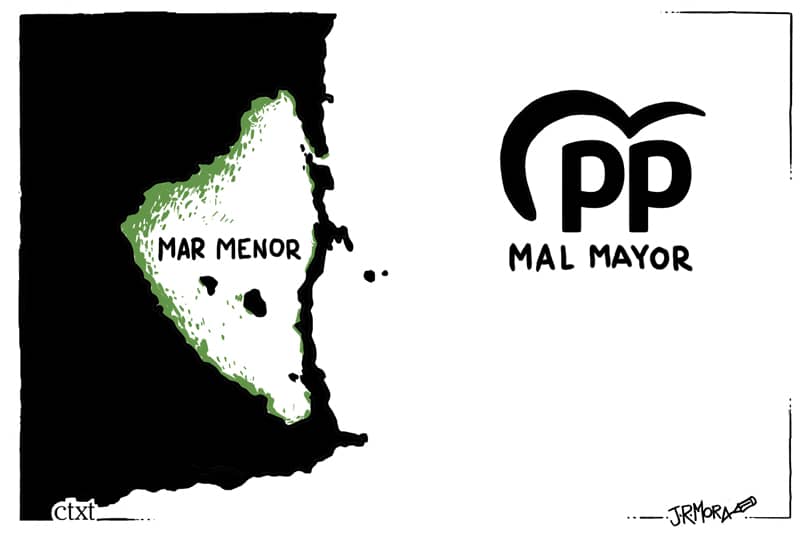
Mar Menor
28/08/2021 cartoon in CTXT
If you are one of those who believe that you get your information from Twitter, by now you will be busy with any of the other nonsense that is going around or that is at the head of the Trending Tontics and by now you must be reading a hundred thousand opinions instead of the most in-depth information on the issue in question, whatever it may be.
And let's face it, few are spared from falling into the loop of the micro-worlds of our respective echo chambers. Rare is the day that I don't stumble across one of them, and it's not unusual for me to get soaked by a pile of headlines a bunch of times. The day will come when the expiration of topics will be measured in zeptoseconds.

Amongst all these topics, the Mar Menor issue passed and, fortunately, stayed on the attention menu a little longer
For some, it was the new thing and it endured what it endured. As a good radical, you know, by definition one of those who tries to get to the root of things, I went back to refresh everything I couldn't remember about the origin of the problem. When I returned from my trip to the newspaper library, half the world was still engaged in a discussion about the ownership of competences.
Those who have governed Murcia for a quarter of a century were still denying that they had any competences, while at the same time demanding more competences with the usual political skirmish. And the water was not swept away.
To finish, they went back to "legislating" in the heat of the moment, resorting to the same old thing, fines that only turn chronic problems into money without solving them.
Thus, the Government of Murcia approved a decree that modifies the Law for the Recovery and Protection of the Mar Menor and prohibits the use of inorganic or synthetic nitrogen fertilisers in the areas closest to the Mar Menor with penalties of between 5,001 and 50,000 euros, and opened 202 sanctioning files for non-compliance with the law for the protection of the Mar Menor.
Not without effort, I managed to get out of this loop and went back to rewinding.
In 1980, a year after the transfer of water, the Oceanography Institute organised the first conference on the Mar Menor," says Isabel Rubio, from Pacto por el Mar Menor, "and it was said that if all the planned irrigation was implemented, fertilisers and insecticides would reach the Mar Menor and this would wipe out the flora and fauna. Forty years have passed and, despite the scientific community's warnings, the authorities (Confederación Hidrográfica del Segura, part of the Ministry of Agriculture, and the Autonomous Community) have always looked the other way. This has been the trend". Experts say that an ecosystem gives warnings that a disaster may occur. This is what happened in the Mar Menor: "In the mid-1990s there were already very clear voices, supported by irrigation exploitation, pointing to the high risk of eutrophication, as had happened in other lagoons in Europe. It was a threat: posidonia and seahorses were beginning to disappear... and nobody did anything," explains Antonio Urbina.
Source: The Mar Menor is still stuck: a story of agony / Santini Rose, CTXT/ 19 August 2019
As in the case of Aznalcollar and many other "natural" waste, similar or not, only time will judge the seriousness and extent of the problem and will be able to convince us of the magnitude of the current negligence.





